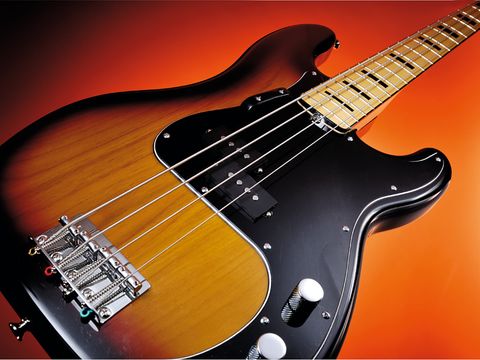When Leo Fender launched the Precision Bass onto an unsuspecting bass-playing populace in 1951 it was met with a degree of distaste and suspicion.
However, it took little more than a quick go on one to win all but the die-hard traditionalists over. Something so much more compact than an upright bass, with the ability to be amplified, was just too good to ignore.
In both the three-tone sunburst and Olympic white finishes this is a very attractive prospect indeed.
It was almost perfectly designed from the start, but by 1957 with a few modifications to the body, headstock and pickup, the Precision as we know it today was complete. The story does not stop there, however, as over the years Fender has continued to offer the beloved P-Bass in a variety of styles and prices.
So surely, then, there's already something to suit everyone? Well apparently not, for here comes the new Japanese-built '70s P-Bass, and it's actually a welcome addition to this already wide range.
In both the three-tone sunburst and Olympic white finishes this is a very attractive prospect indeed. The black block inlays and binding on the maple neck, used originally on the Jazz Bass, are incredibly eye-catching. Add to that the three-ply black scratchplate and the welcome return of the thumb rest (positioned above the strings), and that 1970s vibe is captured brilliantly.
Other features of this model are the F-stamped neck plate, a vintage-style truss rod system, knurled chrome knobs and the appropriate 1970s-style Fender logo on the headstock. There's also a pleasing tint to the maple neck, which gives it a slightly aged look, while the shallow profile and wide 'board make this bass a real joy to play.
Sounds
With all the usual passive electronics in place, this naturally sounds like a good Precision, which means that the reason for choosing this particular version is all about
looks and feel.
The sound, of course, remains fat and solid no matter what position you set the tone control. There's enough top available to make your speakers spit out the notes, but it's the warmth and depth of the bottom end that gives the foundation for consistently great sounds.
Most players work with the tone control slightly off centre, using a treble bias for the funky or hard rock stuff and a bass bias for the traditional old-school sounds, but with well-defined notes.
This period of Fender basses has been all but forgotten - it was a time of old jigs producing poorly fitting parts. But some good designs also emanated from this period that are worth remembering.
Manufacturing problems are now a thing of the past and this model offers a striking combination of 1970s elements and is a welcome and justified addition to the vast current P-Bass catalogue.
Surprisingly, there are only three current P-Bass models that are manufactured in Japan - the other two being from the Steve Harris Signature model and the Sting. In short, if you like the look, the sound and playability won't disappoint.
...

